Business
America's Best Communities competition ends for Le Roy and Bergen, but not revitalization effort
It's the end of the competition, but not the end of the line for Le Roy and Bergen, Legislator Shelly Stein said today after learning that the two communities will not be finalists in the America's Best Communities competition sponsored by Frontier Communications.
The joint effort by Le Roy and Bergen to enter the competition, which could have resulted in a $3 million prize to spend on economic development, did lead to a $50,000 grant to develop an economic development plan, and that will pay off for the northeastern corner of Genesee County for years to come, Stein said.
"We already won," Stein said. "We had the $50,000 that we were able to take from Frontier and match that up with a long-term revitalization and economic plan for both Le Roy and Bergen. It brought out communities together and we found some significant commonalities that we can work towards. Having that plan in hand is something both communities can work from going forward."
The contest has proven highly competitive, said Claudia Maroney, area general manager for Frontier.
'It was a great plan," Maroney said. "They put a lot of effort into it. There were 50 communities that submitted great plans, and unfortunately, Le Roy did not make it to the finalist round."
The planning and cooperation process led to some great community events, some great meeting of the minds and the realization there were projects the communities could undertake outside of the ABC competition.
The grants applied for and received during the process include $420,000 for land acquisition at the Le Roy Tech Park, the Village of Le Roy is getting $100,000 for downtown sidewalks and $20,000 for a waterfront strategy plan; and the Village of Bergen is getting $20,000 for a revitalization plan and $30,000 to study upgrading the sewer system.
All of these activities gained support and are better guided by the revitalization and economic development plan developed for the contest, Stein said.
And through the process, the communities learned a little bit more about themselves, too.
"Everyone is just a little bit more aware of how our community has a great reputation," Stein said. "We have a great work ethic. We really didn't know that our workforce is so highly skilled and that got pointed out during the process. We walk a little taller. We have a smile on our faces a bit longer and there's a bounce in our step."
Funeral services announced for Mike Houseknecht
Funeral Services for Michael R. Houseknecht, a successful local businessman and devoted father, will be at 10 a.m., Tuesday, at St. Joseph’s Church, 303 E. Main St., Batavia.
The 38-year-old Houseknecht passed away unexpectedly early Thursday morning.
He leaves behind his wife of 15 years, Jennifer Anne Thornton Houseknecht, and the daughters he cherished, Meghan Elizabeth and Ella Grace.
Most recently, Houseknecht opened the House O' Laundry on West Main Street in Batavia. He also owned Statewide Machinery. He formerly owned Loose Ends Vending.
A 1995 graduate of Batavia High School, he earned a bachelor's degree in business from SUNY Brockport in 1999.
He is also survived by his mother Sheila Mitchell, of Batavia, and his father and stepmother Ralph (Buddy) Houseknecht Jr. and Katy Gorton Houseknecht, of Perry, as well as his paternal grandparents, Ralph and Agnes Houseknecht Sr., of Stafford.
Friends may call on Monday from 2 to 8 p.m. at the H.E. Turner & Co. Funeral Home, 403 E. Main St., Batavia.
For his full obituary, click here.
Photo: File photo from the opening in November of House O' Laundry. Micheal Houseknecht with daughter Ella.
The promise and the peril of 1366 Technologies discussed at public hearing on tax incentives
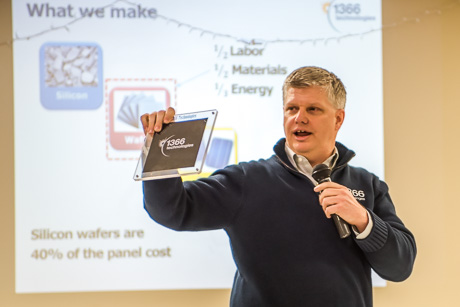
After the questions, concerns, challenges and outright objections to 1366 Technologies coming to the Town of Alabama to build silicon wafers to capture the energy of the sun, resident Dave Dunn said, "I think we've all forgot one thing here tonight: Thank you for coming here."
That statement drew a round of applause from most of the 75 or so people who attended the public hearing Tuesday night on proposed tax incentives to help Bedford, Mass.-based 1366 Technologies build its $700 million facility on 105 acres of the planned high-tech park known as STAMP (Science & Technology Advanced Manufacturing Park).
There were only a handful of speakers during the hearing, and only a couple more who raised objections during a follow-up question and answer period, including one man who stormed out during an impassioned speech by Steve Hyde, CEO of the Genesee County Economic Development Center, on the need for economic development to help keep our children in Western New York.
The state is planning on spending more than $5 million on land acquisition and infrastructure to make STAMP possible, and 1366 could receive another $56 million in incentives from New York along with tax abatements of more than $35 million through GCEDC.
It is those local incentives that the GCEDC Board will be asked to approve in an upcoming vote and last night's public hearing was required in advance of it.
Mark Masse, VP of business development for GCEDC, opened the hearing with an overview of the financing and financial impact of the proposed 1366 project.
The venture is expected to lead to 1,000 jobs at the plant within a few years, with another 1,593 jobs generated by companies that will provide services and support to the new company, and some 2,600 jobs created by local economic growth.
That's more than 6,500 local jobs within 10 years, Masse said.
Entry-level jobs will start at $16 an hour, with production jobs going up to $24 an hour based on duties and experience.
The 1366 payroll is expected to reach nearly $40 million. The indirect payroll could exceed $60 million and induced jobs would add another $30.3 million in payroll, for an anticipated increase in local payroll of $130 million. (CORRECTION: In my notes, I left off some zeros. The payroll numbers have been updated to correct that mistake.)
To help finance the project, GCEDC is proposing a PILOT -- payment in lieu of taxes. That's a break on the property tax. There would be property tax due on the current assessed value of the 105-acre parcel, but there would be no new taxes on the increase in assessed value over the first two years of the project. The taxes would then gradually increase over the next eight years.
There are also proposed tax abatements on the sales tax on construction materials as well as relief from the mortgage tax.
Masse then turned the floor over to Brian Eller, chief operations officer for 1366, who shared some of his company's plans and an overview of what 1366 will manufacture.
Eller explained that 1366, working with scientists at MIT, have developed a whole new manufacturing process for silicon wafers -- the main component of solar panels, that the company believes will be cheaper to manufacture and produce less waste than the process used by every other company in the world.
Silicon is the second most plentiful mineral on Earth and is usually extracted from sand. For solar wafers, manufacturers receive ingots of silicon that are typically cut and ground into square objects.
That's an extremely wasteful production process, according to a video Eller played for the audience. Much of the silicon is wasted, as well as the blades and diamond-tipped twine used to cut the wafers.
The process developed at MIT involves melting the silicon and rolling out flat wafers, much like modern glass manufacturing.
The process is a third faster and a third cheaper than current techniques, and no silicon goes to waste, and it uses less energy.
The goal of 1366 is to use its technology to produce wafers that eventually make solar power as cheap to consume as coal energy.
What 1366 isn't doing is making entire solar panels. They are only making the wafers, and they aren't making solar panels.
Elon Musk's Solar City plant, going up in Buffalo, will make rooftop panels, but 1366 isn't producing wafers for rooftop panels, so there isn't currently an opportunity for the two companies to work together directly. The wafers produced by 1366 are intended for industrial solar energy farms, which currently makes up 70 percent of the worldwide solar energy market.
One speaker during the public hearing expressed concern that 1366 would get all of these tax breaks, build this big building, and then pull out like Pepsi did with the Quaker Muller Dairy plant.
There are, however, some significant differences between the Quaker Muller operation and 1366's plans. Pepsi and Muller entered a market that we now know was saturated in an industry that is so competitive that profit margins are always squeezed. There was no chance for Muller's imitation Greek yogurt to achieve a dominant market position.
In his best-selling business book, "Zero to One," venture capitalist Peter Thiel says new businesses should be built around innovations that are a 10-times improvement over anything currently in the market. Thiel also advises startups to aim for only a segment of a market and achieve dominance in that segment before growing. Pepsi and Muller appear to have violated both of those guidelines by entering a market that already had dominant manufacturers, such as Chobani, Dannon and Fage, and aiming for a share of the entire market, not just a segment where it might have a chance to dominate.
Eller thinks that 1366's lower cost, less wasteful process is that 10-times improvement Thiel recommends (though he hadn't yet read Thiel's book when asked about it) and that 1366 is going after a segment of the market where it can achieve dominance.
Only a portion, less than $100 million, of $700 million required to build the 1366 Technologies plant to full capacity is coming from public investment. There is also a $150 million loan guarantee backed by the Department of Energy. When the project was announced at Genesee Community College in October, company CEO Frank van Mierlo indicated he was investing his own money in the project. The company has reportedly raised $70 million in venture capital from investors such as Hanwha Chemical, a major user of silicon wafers, as well as from Ventizz Capital Fund, North Bridge Venture Partners and Polaris Venture Partners. The company has not discussed any other efforts to raise additional capital or the timing of capital needs. They would not need the entire $700 million in the bank to start construction.
Construction is expected to start in May or June.
The first jobs should be filled in the fall or early winter of this year, with hiring continuing through the middle part of 2017 and then more jobs added as production capacity is increased.
Eller will move to here from Bedford to join the ranks of the locally employed, along with as many as five current 1366 managers and executives, though the company will remain headquartered in Bedford. That's also where the company will continue research and development operations.
There was a bit of discussion between Eller, Masse and meeting attendees about workforce development and who will get hired at the new plant.
Lorna Klotzbach had several objections to the proposal, among them were questions about whether there were really sufficient potential employees in the region. She also shared with some other speakers a concern that STAMP was converting farmland and wildlife refuge into industrial land.
Al Files, who would later get up in a huff and storm out during Hyde's speech, said he thought it made a lot more sense to build where there's already big buildings and infrastructure.
"In my opinion, I think it's stupid," Files said. "We're wasting all of this property when it could be built in Rochester, Buffalo or Batavia."
Eller said 1366 was attracted to STAMP, out of 300 locations considered, for two primary reasons. First is cheap and clean hydroelectric power, and then there is the regional workforce. Eller said the company hired a consultant who studied a number of variables for several possible plant locations and STAMP scored the highest for workforce potential.
Creating local jobs and reversing two generations of economic decline is what STAMP is all about, Hyde said.
"At the end of the day, what drove us to work so hard to attract a company like 1366 to our community and our region is creating jobs for our kids so they can either stay here or come back home," Hyde said. "All the rest of these questions are good and relevant, but if we take a little look at the big picture, we’ve all been losing tax base and these guys are going to start that trend of turning that around.
"We can’t guarantee that companies are going to be successful, but even with the situation in Batavia, where Muller Quaker was, we built that ag park, two companies came in and spent over $200 million there. The market didn’t work. They entered the market late. They ended up having to shut down and that’s a disappointment, but the beauty is, one of the best dairy companies in the nation is coming in because that ag park is there and they're filling it back up and probably hiring more people than Muller ever would have. The investment model that we’ve used over the last decade is working. It’s creating good jobs for our people and our community. It’s creating tax base.
"I just wanted to paint a little bit of the bigger picture," Hyde added a few sentences later. "We’re absolutely fortunate to have a company like 1366 be willing to come here and start to build that high-tech, entrepreneurial ecosystem. It will mean a lot of jobs for our kids. … I’ll tell you right now if we get a thousand jobs from this company over the next decade, and that turns around to be about four thousand jobs all over this area, you’re going to see an economic boom around here that we haven’t seen in 50 years."
At which point, Files interjected, "This is an agricultural area. This is not a manufacturing area."
Hyde said projects like 1366 will take the pressure off of ag to support the entire local economy, and that the land the plant will use is less than 3 percent of the available acreage in Genesee County, and it's the least productive land in the county.
"We looked at all of that," Hyde said.
But Files was no longer in the room to hear it.

I couldn't find online the video Eller showed, but in looking for it, I found this interesting video.
Tompkins acquires Shepard, Maxwell & Hale Insurance
Press release:
Tompkins Financial Corporation has announced the acquisition of Shepard, Maxwell & Hale Insurance by Tompkins Insurance Agencies, Inc., an affiliate of the financial corporation. The acquisition was effective Jan. 1.
“We are happy to continue to grow our business in Batavia and serve our neighbors through this expansion,” said David S. Boyce, president and CEO of Tompkins Insurance.
The change is a win-win for customers, Boyce said.
“In addition to continuing to receive personal attention from local insurance professionals who place a high value on customer service, customers will have 'one-stop shopping' access to the comprehensive array of financial solutions offered by our affiliation with Tompkins Bank of Castile and Tompkins Financial Advisors,” Boyce said.
According to Boyce, Daniel G. Hale and Stephen S. Maxwell, will remain with the agency. Most current employees will be retained in the merger and will continue to service accounts. The Batavia location of Shepard, Maxwell & Hale will close and move operations to the Tompkins Financial Center at 90 Main St. on or about Feb. 1. The Hamlin office will continue to operate at its current location for the time being.
Effective Feb. 1, clients of Shepard, Maxell & Hale may receive service at any of the 28 locations throughout New York and Pennsylvania, including the 16 locations in Western New York.
Tompkins Insurance serves 30,000 personal insurance customers and 7,600 commercial insurance customers, making it the third largest commercial insurance firm in the Rochester area and the 82nd largest agency in the country. The acquisition will add the approximately 4,000 Shepard, Maxwell and Hale accounts to its customer base.
Established in 1957, Shepard, Maxwell & Hale has a long history of serving western New York through its two offices in Batavia and Hamlin. The merger with Tompkins Insurance makes sense for customers, according to Hale.
“Along with continuing to receive top-notch service, our customers will see additional benefits like access to 24/7 claims service 365 days a year, and more price and product options offered through Tompkins’ relationship with 50+ leading insurance companies,“ Hale said.
Tompkins Insurance Agencies, Inc., operates 16 offices in Western New York, six offices in Central New York and six offices in Southeast Pennsylvania. A part of Tompkins Financial Corporation, (trading as TMP on the NYSE - MKT), the agency is affiliated with Tompkins Bank of Castile, Tompkins Trust Company, Tompkins VIST Bank and Tompkins Financial Advisors. It is an independent insurance agency offering personal and business insurance and employee benefits services through more than 50 different companies. Further information is available at www.tompkinsins.com.
Empire State Development announces $5 million grant for STAMP
Here's a portion of a press release from Empire State Development about a series of grants recently approved.
Empire State Development today announced that its Board of Directors recently approved $101.1 million in economic development resources for 23 projects that are spurring growth and opportunity in every region of the state. The funding supports projects that are creating 634 new jobs and retaining 1,531 existing New York State jobs – many of which have already been created or retained. The approved assistance is leveraging more than $822 million in private investment and other public funding to support local businesses and projects that are strengthening local economies today, while building a strong foundation for future economic growth and job creation.
“The funding approved by the Board is supporting regionally significant projects that are fostering growth and creating new opportunities statewide,” said Empire State Development President, CEO & Commissioner Howard Zemsky. “Whether it’s by aiding business expansion and retention, supporting local revitalization projects, or bolstering regional tourism, the funding approved today will boost economic activity from New York City to the Finger Lakes.”
...
Finger Lakes Region
Western New York Science, Technology and Advanced Manufacturing (Finger Lakes Region - Genesee County) – $5,000,000
The Genesee County Industrial Development Agency, doing business as Genesee County Economic Development Center (GCEDC), will use a grant of up to $5,000,000 for the cost of land acquisition, engineering, and soft costs related to infrastructure development for 1366 Technologies, Inc., the first tenant of the Western New York Science, Technology and Advanced Manufacturing Park (STAMP) in Alabama, NY. 1366 Technologies is a solar energy company with an innovative approach to manufacturing the silicon wafers that are the building block of solar cells. The company chose the STAMP site out of 300 possible locations due to the site’s positive momentum and commitment to growing manufacturing interests. This project will be completed in August 2016 and aligns with the Finger Lakes Regional Economic Development Council’s plan in that it supports advanced technology and manufacturing and is identified as key to the region in the Industrial Development and Infrastructure category.
New owner for Le Roy’s Main Street Fitness; open house is Sunday
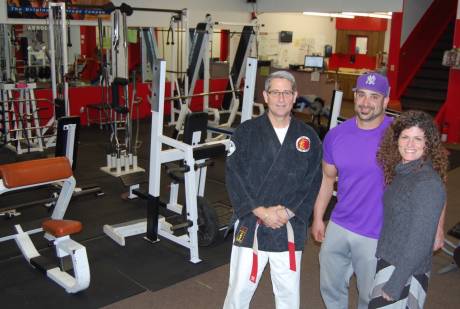
Michele Martinez, right, is the new owner of Main Street Fitness in Le Roy. She bought the business from Fred Merica, left, who will continue to operate Le Roy Karate at 66 Main St. Martinez is joined by her fiance, Dan Saeva, whom she met at the gym.
Being a competitive weightlifter meant Michele Martinez was very serious about her workouts at Le Roy’s Main Street Fitness.
It also meant lots of advice for the gym’s proprietor.
“The truth is, Michele used to break my chops a lot,” Merica joked earlier this week. “ ‘You’ve gotta clean, you’ve gotta buy this, you’ve gotta buy that.’
“Finally I said, ‘Why don’t you just buy the place and do whatever you want with it!' ”
Which is pretty much what finally happened.
Martinez, who lives in Le Roy, took ownership this week. She’ll be leasing space from Merica, who owns 66 Main St. and will continue to own and operate Le Roy Karate.
Martinez is looking forward to meeting the public and sharing her plans for Main Street Fitness during an open house from 10 a.m. to 3 p.m. Sunday.
Main Street Fitness grew out of the karate studio Merica, 54, established in 2005. He gradually added weightlifting equipment to diversify the business. Now, the gym also features a cross-training room; a cardio room equipped with treadmills, stair machine and Arc Trainer (sort of a cross between a treadmill and an elliptical machine); and, in the basement, a circuit-training room.
In short, something for every age, skill level and interest.
“Everyone thinks it’s just weights, and it’s not,” Merica said. “I think that’s what separates this gym from most gyms in the area.”
It’s also a 24-hour operation, with keyless entry available to members. Merica said he preferred to focus on karate, and needed to find someone who could give the gym the attention it demands.
He said Martinez is the ideal buyer.
They met in 2012, when Martinez enrolled her daughter Skyler, now 11, in one of Merica’s karate classes. At the time, Martinez was in training — at different gym — for the Ms. Buffalo Bodybuilding Championships.
“We started talking, and he ended up letting me work out up front to supplement my training,” Martinez said.
She went on to win second place in the women’s heavyweight division in 2012. The following year, she claimed first place.
“That’s one of the reasons I thought Michele would be a perfect fit,” Merica said. “It adds another component to the gym, because she’s competed; she’s got that experience.”
But Martinez was reluctant to take on the responsibility. She already works full-time as a training manager for Sutherland Global Services in Rochester; is a part-time sign-language interpreter; and is also raising a second daughter, 9-year-old Kori.
Her outlook changed with her engagement earlier this year to Dan Saeva, whom she met at the gym. He’ll oversee day-to-day operations at Main Street Fitness, while Martinez focuses on the business side.
Martinez and Saeva, also of Le Roy, are planning an April 26 wedding in Puerto Rico.
Meanwhile, Martinez doesn’t expect major changes at Main Street Fitness. She will rearrange existing equipment in a way that makes better sense for bodybuilders, add more powerlifting equipment, and do some remodeling. Her contacts in the fitness field may mean expanded services, including nutrition supplements, fitness beverages and benching competitions.
She’ll also have special offers, including discounted rates on group memberships.
“I’m excited,” Martinez said. “I’m overwhelmed; I’m anxious. I think this next month will be the real test for us.”
For his part, Merica said he’s grateful to longtime members for their support as he bows out of the gym business. But he’s also thankful to have less on his plate.
“I’ll be getting more sleep,” Merica said.
And Martinez?
“I’ll be getting less,” she said.
For more information about Main Street Fitness, visit www.fitness-karate.com.
Chapin Manufacturing honors employee for 50 years of service to Batavia-based company
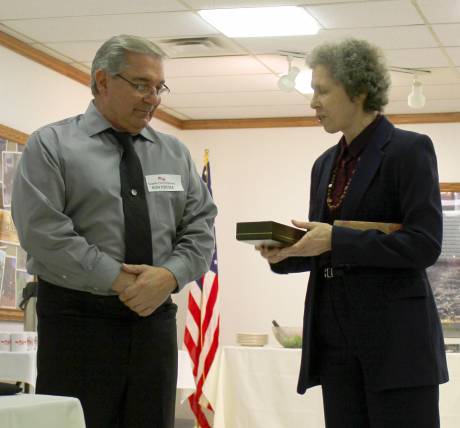
(Submitted photo and story from Chapin Manufacturing, Inc.)
We do not often these days hear about lifelong employment and people who spend their entire career at one company. But, that very thing has happened here in Batavia at Chapin Manufacturing. Batavia native Ron Odessa joined Chapin in September 1965 and just celebrated his 50th anniversary with the company.
Mr. Odessa’s anniversary celebration was capped off by a presentation of a solid gold “Chapin Chip” presented to him at the annual shareholders’ luncheon by Andris Chapin, chairman of the Board of Directors. He accepted the gift graciously, saying with a sly grin, “Things are going well here, I’m thinking about making a career of it.”
Upon close inspection, a visitor might notice the name Ronald Odessa on many of the patents hanging in the hallway at Chapin. These innovations were made possible by Ron’s imagination, creativity and pragmatism developed during a lifetime spent in Manufacturing, Engineering and Quality.
In his spare time, Mr. Odessa, an eighth degree Black Belt, teaches martial arts at Borell’s Karate Academy in Batavia, and was once considered somewhat of a rock star having played in a well-known Batavia-based band in the 1950s.
Chapin International, Inc., is a manufacturer of compressed air sprayers and broadcast spreaders. Homeowners and commercial customers know the familiar red Chapin logo means quality, innovative engineering and quality.
Bergen-based Liberty Pumps celebrates 50 years in business, employees wish everyone 'Happy Holidays'

Bergen-based Liberty Pumps, which is celebrating a half century in business this year, sent us this photo to share with you of their entire crew. They wish everyone "Happy Holidays!"
County's year-over-year unemployment rate dips for November
Genesee County's November unemployment percentage hit its lowest rate in nearly a decade, according to data released today by the Department of Labor.
The November rate was 4.6, which is better than the 5.1 rate a year ago, and better than the 8.5 rate at the height of the recession in 2009.
The rate in 2006 was 4.1 and it was 4.7 in 2007.
The October 2015 rate was 4.2. The November rate is traditionally higher than the October rate.
There are 200 more Genesee County residents employed in 2015 than a year ago, with 28,200 reportedly having jobs.
The GLOW region unemployment rate is 4.8 percent, compared to 5.6 percent a year ago.
There are 22,700 non-farm jobs in the county, compared to 22,900 a year ago and 23,200 in October.
Photo: 'Merry Christmas vets!'
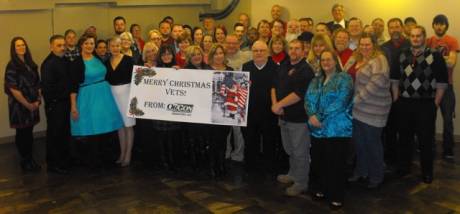
Employees of Orcon Industires paused to wish America's veterans a Merry Christmas during the company's annual holiday party Friday at Batavia Downs.
Workers at the Le Roy company recently decided to donate their year-end bonus to the Liberty Fund, a North Carolina-based organization that provides all-terrain wheelchairs to wounded veterans. Orcon management matched the donation, allowing for the purchase of two wheelchairs.
News of the donation reached Fox News commentator Bill O'Reilly — a major supporter of the Independence Fund — who thanked the Orcon team for their donation during an "O'Reilly Factor" broadcast last week.
(Submitted photo.)
Charles Men's Shop wins Downtown Holiday Window Decorating Contest
Press release:
The Batavia Business Improvement District (BID) would like to announce the winner of the Downtown Batavia Holiday Window Decorating Contest. It is Charles Men’s Shop, located at 200 E. Main St.
As the winner of the contest, Charles Men’s Shop will receive $200 as the prize for the best window. Second and third place were Adam Miller Toy and Bicycle, and Art Ah La Carte, respectively.
The annual contest is a chance for downtown businesses to not only put their best foot forward in decorating their windows, it is also an opportunity for them to encourage people to come downtown and walk around, hence “More Feet Downtown.”
Ten judges, who are senior ladies, were driven by bus, which was provided through the Genesee County Office for the Aging. Anita Dziekan, of Batavia, coordinated the group and provided them with Santa hats and made the experience a very merry morning. The judges walked around the downtown and viewed 16 windows.
Even before the official judging today, Dec. 21, the judges also looked at the windows at night to see the displays lit up. The judges were impressed not only by the display, but also admitted that their window looks wonderful and inviting even at night.
The judges ranked the windows based on certain criteria, such as creativity, attracted a person to want to go inside, or if the content was related to their business, among other criteria. For example, the judges liked that Councilperson Rosemary Christian took the time to decorate one of the Carr’s vacant windows.
“Given the great weather, they were able to walk around a lot more and discuss the windows and what they saw downtown. It was very insightful to hear their comments,” said Laurie Oltramari, BID executive director.
“Walkability is my primary focus for the downtown. If people do not want to walk around, they will not stay or even come. It is a simple answer to a complex set of challenges.”
You can post on the Downtown Batavia Business Improvement District Facebook page or contact Laurie Oltramari at (585) 344-0900 or e-mail LOltramari@DowntownBataviaNY.com to share pictures or to ask questions about the contest. Please contact David Howe at Charles Men’s Shop at (585) 343-2086 to coordinate a time to take a picture of their windows!
Le Roy investment group has high hopes for new year
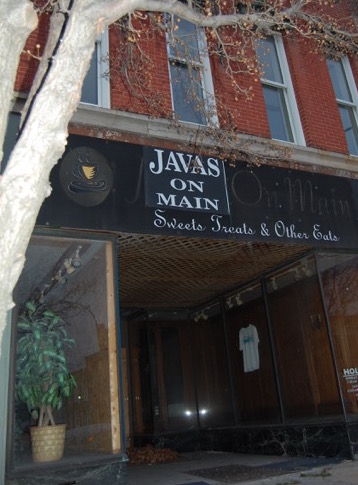
The investment group Le Roy New York, LLC, is hoping its plans to renovate 24 Main St. will move forward next year.
A group of Le Roy investors is hoping their efforts to renovate 24 Main St. kicks into high gear in the new year.
The Le Roy Board of Education in January will consider offering tax breaks for projects like the one proposed for 24 Main St. Plans call for its conversion to a mix of commercial and residential uses.
The school district is the last of four taxing entities being asked to offer the tax incentive.
Meanwhile, a revitalization group that has been pushing for the creation of a downtown historic district, hopes to win state approval by March. When that happens, properties within the district would be eligible for preservation tax incentives.
The investment group, Le Roy New York, LLC, was created in 2013 in an unsuccessful effort to save the former Wiss Hotel from the wrecking ball. The group turned its attention to 24 Main St. — the former Java’s coffee shop — last year, and announced plans to convert the property to ground-floor retail with three apartments on the top two floors.
The LLC is hoping to raise $250,000, and so far has $180,500 toward that goal, said Bob Fussell, a village attorney and LLC member. He said tax incentives are essential for attracting new investors.
“We’re not going to start the project until we find out whether the schools approve (the exemption) and until we find out whether we get into the historic district,” Fussell said.
“Once those things are done, it’s going to make sense to invest,” he added. “But until then we’re not giving the investors the full advantage.”
The Residential-Commercial Urban Exemption Program (Section 485-a of the state Real Property Tax Law) allows municipalities, counties and school districts to offer a declining, 12-year partial property tax exemption for non-residential property converted to a mix of residential and commercial uses.
Projects must cost at least $10,000 to be eligible. Properties are 100-percent exempt from taxes on assessed value attributed to the conversion project for the first eight years. The exemption then gradually falls to 20 percent in the final year.
Counties and school districts are allowed to approve the exemption program once the municipalities have done so.
The Le Roy Village Board approved the program on July 22. The Town Board followed suit on Aug. 27, although councilmen included a provision limiting its application to buildings within the planned historic district.
The Genesee County Legislature adopted the program after a public hearing on Nov. 23. The Le Roy Board of Education has scheduled its own public hearing for 7 p.m. Jan. 12.
Fussell said the program encourages local investment, without cutting local tax revenue.
“It’s not like we’re not going to be paying taxes on the property,” Fussell said. “We’re just going to be paying the same taxes we are now.”
Although an investor could claim the tax exemption for conversion of any property in Le Roy, its focus is effectively on the village’s commercial district.
“The whole object is to revitalize Main Street,” he added. “The idea is to take buildings that are degrading and falling apart, and make them vibrant and successful.”
A minimum investment in the project is $1,500. For more information, visit www.24mainleroy.org.
Tax incentives offered via inclusion in a registered historic district, may take longer to materialize.
The Preservation League of New York State awarded a $4,000 grant to Le Roy in October 2014. The grant was to hire Preservation Studios of Buffalo to complete a State and National Register of Historic Places nomination for a historic district in Downtown Le Roy.
The grant was secured by the Main Street Revitalization Committee, under the auspices of the Le Roy Business Council.
Jennifer Keys, who chairs the committee, said state approval has taken longer than expected.
“Apparently there was a combination of things,” Keys said. “The project was a little bit bigger than (Preservation Studios) thought it would be. At the same time, they had pretty massive growth as an agency and they were understaffed.”
The state Office of Parks, Recreation and Historic Preservation rejected the first draft of the nomination submitted this past summer. Preservation Studios was able to dedicate staff to the project, and a second nomination was submitted in late October, Keys said.
The hope is that Le Roy’s application will come up for review sometime in March, Keys said.
“It’s definitely taking a lot longer than we thought it would, but it is moving forward,” Keys said.
Le Roy ZBA conducts hearing on Frost Ridge
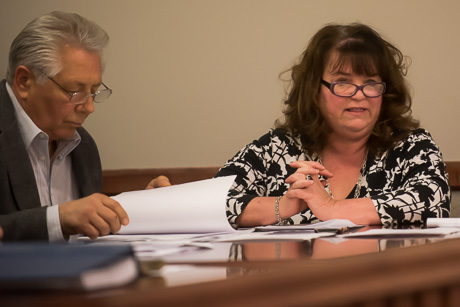
The Le Roy Zoning Board of Appeals conducted a public hearing Thursday on Frost Ridge Campground. Pictured, is Board Member Thomas Spadaro and Chairperson Debbi Jackett. (Photos by Howard Owens.)
After months of legal wrangling, the argument over concerts at Frost Ridge Campground on Thursday returned to where it began.
With the Le Roy Zoning Board of Appeals, whose members listened to about 90 minutes of testimony and public comment on whether the concerts are an allowable, non-conforming use under town zoning law.
The board adjourned without voting. Debbi Jackett, chairperson, said the ZBA has 62 days in which to issue a decision.
About 60 people attended the hearing, which was held in Town Court. The hearing was conducted a day before a deadline set by a Supreme Court judge earlier this month.
The ZBA in 2013 ruled concerts allowable. Neighbors as well as the Town of Le Roy subsequently filed lawsuits aiming to reverse that decision.
On Thursday, the ZBA heard formal testimony from David Roach, attorney for Frost Ridge owners David and Greg Luetticke-Archbell; and from Mindy Zoghlin, an attorney representing families who are opposed to the concerts.
Roach maintained that the “campground and attendant recreational activities, including amplified music/concerts and limited food service” are all prior, non-conforming uses.
Citing case law, he said larger outdoor concerts may represent a change in degree, but do not alter the “essential character” of the facility and are still considered an allowable prior use.
Zoning law draws no distinction between concerts by small bands with lower amplification, and performances on a large stage using a professional sound system.
“What’s the difference? They both emit sound — that’s what we’re dealing with,” Roach said. “The primary difference is that one is louder than the other.
“What I suggest to you is that’s not a land-use issue, that is a noise ordinance (issue),” he added. “Anyone who has an issue with the decibel levels can seek relief through the noise ordinance, not through the land-use argument.”
Zoghlin urged the ZBA to reject the Frost Ridge application. Outdoor concerts of the type Frost Ridge has been hosting, are beyond what could be reasonably considered prior use.
“Even if music was played in the campground for skiers and campers in the past, Frost Ridge has illegally expanded that use,” she said.
“There’s a big difference between using an amplifier to play radio music, and hosting large commercial concerts on a specially constructed sound stage using professional audio equipment,” she said.
“Concerts with national acts, a professional stage and a sound system that attracts hundreds of people at a time were never held at this campground until 2010,” Zoghlin said. “Therefore they cannot be a prior non-conforming use as a matter of law.”
Reid Whiting, attorney for the Town of Le Roy, was offered the opportunity to give formal testimony but declined.
Thirteen residents also spoke, several of them in support of Frost Ridge.
Barbara Buchanan has lived on North Road near the campground since 1974.
“Frost Ridge has a history of providing music from different venues,” she said, including amplified music on the ski slopes.
“None of the music, over 40 years, has ever bothered us,” she said. “We consider the campground to be a very good neighbor — we don’t have a single complaint against them.”
Not so for Nancy Palmer, who has lived on Wilcox Road since 1997. She said summer concerts at Frost Ridge are too noisy.
“I find it very disturbing,” she said. “I can hear it through my house … I can hear the bass pounding through my walls and through my windows.”
Palmer said the concerts are loud enough to spook her horse.
“For those of us who are close, it is very loud and it is very disturbing,” she said.
Others speakers cited the positive impact Frost Ridge has on the community, such as fundraisers for the Le Roy Fire Department.
David Pullyblank, of Parmalee Road, said Frost Ridge campers support local businesses — including the farm market he owns on Lake Street Road (Route 19).
“Campers are people that want to come to our community and spend money,” he said. “I think it’s essential to have their business in our area.”
The Luetticke-Archbells have owned the Conlon Road campground since 2008, and have been hosting concerts in an outdoor amphitheatre since 2012. In 2013, the ZBA found the concerts permissible under zoning law.
Neighbors of the campsite and the Town of Le Roy both filed lawsuits challenging the ZBA’s ruling. Supreme Court Judge Robert Noonan invalidated the decision in April on technical grounds, and ordered the ZBA to conduct a new public hearing.
In November, the Town Board set a Dec. 10 public hearing on a local law to establish a new, town-only zoning board. Earlier this month Interim Supreme Court Judge Mark Grisanti ordered the town to cancel its hearing, and ordered the existing ZBA to conduct a hearing on Frost Ridge by Dec. 18.
Jackett set a number of ground rules at the beginning of Thursday’s hearing. Attorneys submitted written statements and evidence, but were given limited time to address the board directly. Residents who signed in, were allowed one minute to speak.
ZBA member Robert Scott, who ran unsuccessfully for town supervisor against incumbent Stephen Barbeau in November, recused himself from any involvement in the Frost Ridge application.
Jackett did not indicate when she expects the ZBA to issue a ruling. Comments on the matter will be accepted in writing by the Town Clerk until Dec. 27, she said.
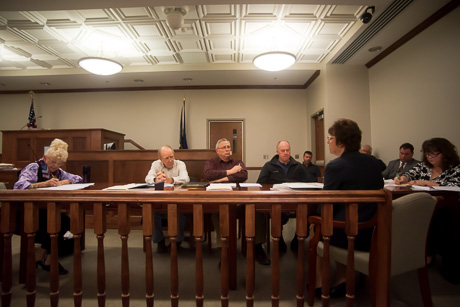
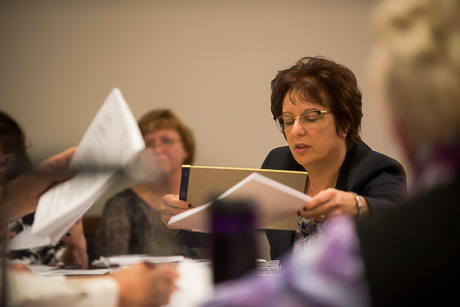
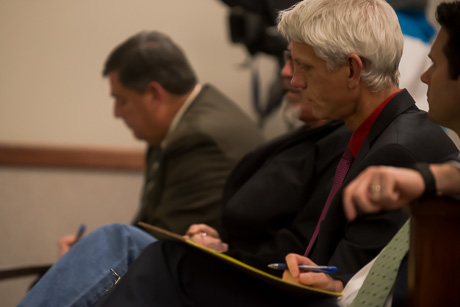
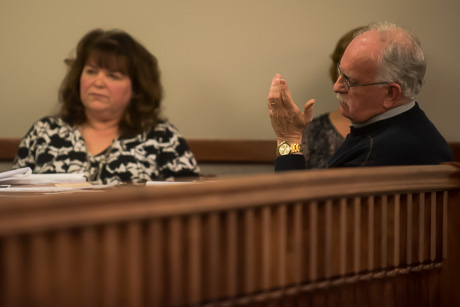
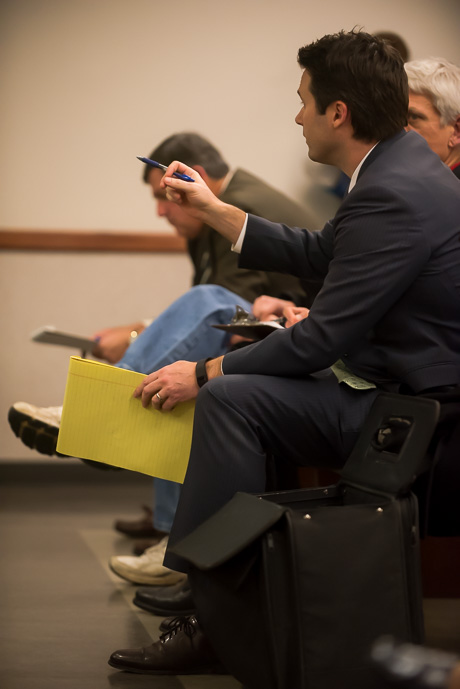
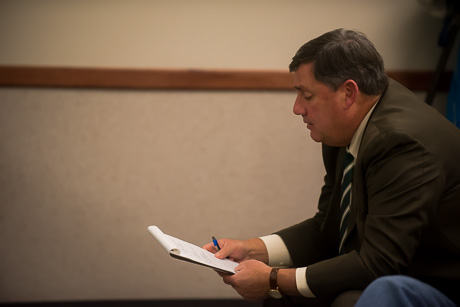

GCEDC will hold public hearing on 1366 Technologies application
Press release:
The Board of Directors of the Genesee County Economic Development Center (GCEDC) authorized a public hearing for 1366 Technologies, Inc., and approved a final resolution for an amendment to an original application for assistance from Manning Squires Hennig Co., Inc., at the agency’s Dec. 17 board meeting.
1366 Technologies, Inc., plans to build its first commercial Direct Wafer™ production plant at the Science and Technology Advanced Manufacturing Park (STAMP) in the Town of Alabama.
The project includes the construction of a new 130,000-square-foot manufacturing facility that will grow to eventually create 1,000 full-time jobs and approximately another 5,000 construction and indirect and induced jobs. The total economic impact is preliminarily estimated to be in the range of $1.5 billion over the next 10 years.
1366 Technologies, Inc., is seeking approval for approximately $34.7 million in sales, mortgage and property tax exemptions. The planned capital investment will total approximately $700 million.
“As the largest economic development project in the history of Genesee County, 1366 Technologies will undoubtedly be a game changer in establishing our region as a major high-tech manufacturing hub,” said GCEDC Chairman Paul Battaglia. “This project also will create hundreds of manufacturing jobs and indirect supply chain jobs not to mention hundreds of jobs throughout the construction process.”
The GCEDC board also approved amended incentives for Manning Squires Hennig Co., Inc., a well-known general contractor in Finger Lakes and Western New York regions. The company will expand its corporate offices and maintenance facilities in the Town of Batavia by up to 5,000 square feet, as well as renovate its existing shop and office space.
The project was approved for sales tax, mortgage tax and property tax exemptions totaling $215,529 in incentives. The project’s capital investment is approximately $2.2 million.
“We are pleased to see continued investments being made to improve the facilities of existing companies like Manning Squires Hennig in the Town of Batavia,” said Steve Hyde, president and CEO, GCEDC. “We remain committed to help existing businesses in the County expand their operations in our ongoing efforts to enhance the business climate throughout the region.”
In other agency business, the board approved a 2-percent salary increase for all GCEDC staff for 2016, as well as an increase for the GCEDC office manager.
Plenty of talk, no decision at Le Roy ZBA hearing on Frost Ridge
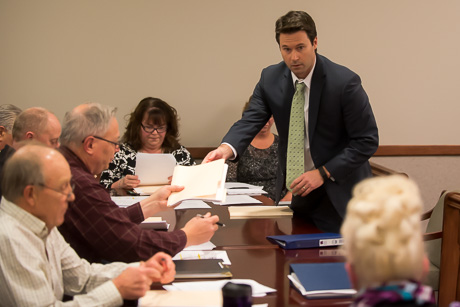
David Roach, attorney for Frost Ridge Campground, offers testimony to the Le Roy Zoning Board of Appeals during a public hearing Thursday on the issue of live concerts at the campground. (Photo by Howard Owens.)
Le Roy’s joint Zoning Board of Appeals reached no decision Thursday night on the question of live concerts at Frost Ridge Campground.
The ZBA adjourned after a 90-minute public hearing on the matter. About 60 people attended the hearing, which was held in Town Court.
Debbi Jackett, the board chairperson, said the ZBA has 62 days in which to issue a decision on whether concerts are an allowable, non-conforming use under town zoning law.
Comments will be accepted in writing by the Town Clerk until Dec. 27, Jackett said.
The ZBA heard formal testimony from David Roach, attorney for Frost Ridge; and from Mindy Zoghlin, the attorney representing families who are opposed to the concerts. Gene Sinclair, who served as the town zoning/code enforcement officer until 2012, also testified.
Reid Whiting, attorney for the Town of Le Roy, did not comment during the hearing.
Thirteen residents also spoke, several of them in support of Frost Ridge. At least two residents, however, said the concerts are disruptive.
Thursday’s hearing was conducted a day before the deadline set by a Supreme Court judge earlier this month.
A complete story will be posted Friday morning.
Le Roy company, workers donate to wounded veterans

Employees at Orcon Industries in Le Roy have decided to donate their first year-end bonus in several years, to an organization that provides all-terrain wheelchairs for wounded veterans. Company management matched the gift, allowing for the purchase of two wheelchairs.
America’s wounded veterans sacrificed to protect our freedom.
This holiday season, employees and management at a Le Roy manufacturer made a sacrifice of their own — to help some of those same veterans better enjoy their freedom.
Workers at Orcon Industries have agreed to donate a portion of their year-end bonus pool, to the Independence Fund. The North Carolina-based nonprofit provides all-terrain wheelchairs and other services to disabled veterans.
The donation amounts to $15,000 — the cost of just one of the rugged “track chairs.”
In light of the employee decision, the management at Orcon — which makes industrial packaging at its facility on Lake Street Road — matched the gift.
“We thought we’d give our employees the opportunity to participate in something that’s pretty meaningful,” said Bruce Olson, the company president and CEO. “Something that they probably wouldn’t have been able to participate in, without us at least being the conduit.”
The key word, is “conduit.” Olson said he is a proud patriot and cares deeply for veterans' issues. But he gave all the credit to the employees.
The Independence Fund was established in 2007 to provide resources and therapies to veterans with service-connected disabilities.
Many veterans had enjoyed hunting, fishing and other outdoor activities before they were wounded. The Independence Fund’s Mobility Program allows them to get back outdoors using a variety of devices, including all-terrain wheelchairs and adaptive bicycles.
“The great thing with the Fund, is that 100 percent of the proceeds go to the soldiers,” said Michael Olson, Bruce’s son and Orcon’s general manager. “There is no administrative cost.”
Proceeds are not spent on publicity, either. In consequence, the Independence Fund is not very well-known.
It does however have a high-profile champion: political commentator Bill O’Reilly. He has not only featured the organization on his Fox News program, “The O’Reilly Factor,” but has helped it provide 1,400 wheelchairs to veterans.
That is how the Olsons first heard of the Independence Fund.
“Michael and I were talking, and we started looking at the year we had last year, which was probably the best year in the history of the company,” Bruce Olson said.
“In the past, we’ve always shared our success with our employees,” he continued. “So we were looking at what we had for a bonus pool this year to give back to the folks and it was, for us, pretty significant.”
They talked it over with partner Rick Flanagan, vice president for package design and engineering. Together, they decided to ask Orcon’s 60 employees if they would contribute to the Independence Fund.
It was a big question. This was the first bonus pool the company has been able to offer in years.
At a company meeting this past Friday, employees watched an “O’Reilly Factor” segment on the Independence Fund. Then they were asked if they would donate.
“The room just exploded in applause,” Bruce Olson said. “The response was overwhelming — tears, hugs, thank-yous.”
There weren’t many dry eyes, he said.
Certainly not his own.
“I’m a really emotional jerk,” he said. “So I lose it — I mean, I literally can’t finish the rest of the story. Michael finally got the message that he had to bail me out.”
The rest of the story was this: The company would match the gift.
“And they went nuts again,” he said.
Olson contacted the Independence Fund on Saturday to let them know Orcon would be making a donation. The Independence Fund, in turn, shared the news with O’Reilly.
And so during his broadcast on Wednesday, O’Reilly took a moment to thank Orcon.
Bruce Olson appreciates the attention. But he hopes any publicity generated by his company’s gift will help spread word about the Independence Fund and the work it does.
The story could have a sequel. Michael Olson said employees are already talking about ways to raise funds to make another contribution next year.
For more information about the Independence Fund, visit www.independencefund.org
To view “The O’Reilly Factor” segment on the Independence Fund, visit https://www.youtube.com/watch?v=onZmuZSl82w
CORRECTED: Town of Alabama officials trying to figure out how to handle proposal from wind company
UPDATE 8:05 p.m.: This story has been corrected to include the right address of the property to be leased from landowner Sam Scarborough, and to reflect the proper per-foot incentive price for the proposed met tower.
A Houston-based energy company would like to figure out if there's enough wind blowing through Alabama to justify building windmills around farmland, so the company is proposing erecting a temporary, 311-foot meteorological tower.
While the town has zoning code that covers wind towers and communications towers, there's no code covering meteorological, or "met," towers.
The ambiguity has delayed a decision by the town board on whether to grant a variance, through what is known as an Incentive Zoning Application, for the tower.
An incentive application involves the company paying an annual fee for the ability to vary from the zoning law.
In this case, EDP Renewables North America, operating as Alabama Ledge Wind Farm, LLC, already agreed to pay a $5-per-foot incentive to construct a tower that exceeds the allowable height.
Over five years, that payment comes to about $18,000.
Town officials think the tower, which will be on land leased from a local farmer, Sam Scarborough, on Gorton Road, should be at least 1,000 feet from Gorton Road.
The current proposed location is 668 feet from Gorton Road.
Using a calculation pulled from the communication tower provisions of the law for setback (the distance from the road), the town is proposing an additional incentive fee of $20 per foot.
That would drive up the five-year cost of incentives to nearly $50,000.
Jim Muscato, attorney for EDP, thinks that fee is unreasonable and excessive.
"The purpose of incentives on a project is to look at what incentives are necessary to allow the project to go forward and come up with a reasonable accommodation for the impacts associated with the project," Muscato said. "What we're talking about here is a met tower where the associated impacts are fairly modest."
While Muscato believes the 1,000-foot setback, as opposed to a setback that doubles the height of the tower, or 622 feet, is excessive, he said his company is willing to go along with that setback definition if the incentive fee is reasonable. He would like the board to propose a reasonable incentive fee.
Town Board Member Kevin Fisher suggested that $20 might be reasonable, but he doesn't have an enough information to know at this point. He doesn't know what the market price might be, and he doesn't know how much of an impact the tower might have on town residents. He hasn't heard from constituents enough to know.
"I don’t think it’s fair to us to say, 'You guys should accept it because you don't have met tower regulations or zoning laws,' " Fisher said. "We didn’t have any reason for any of this stuff until you walked in the door."
Ronald Gilbert, planning board chairman, was in the audience and he reminded the board that some years ago, EDP, operating then as Horizon Energy, proposed a wind farm in Alabama, which is how the current zoning code came to be written, and it was Horizon officials who said then no zoning code covering met towers was necessary because a met tower wouldn't be part of the wind farm.
Town Attorney Mark Boylan said the conversation made him a little uncomfortable because the town is looking at establishing a requirement for incentives based on two sections of zoning code that do not deal directly with met towers. That introduces an element of an arbitrary decision.
When he hears the other attorney, he said, using words such as arbitrary and reasonable and unreasonable and he's offering a compromise, then, Boylan, said he's concerned about the potential for litigation if the applicant finds the board's decision unacceptable.
Muscato said he doesn't mean to imply his client is contemplating litigation, but then added, "I think what a court is going to assess is that a $50,000 payment over five years of a permit is either not calculable or reasonable or whether it is considered arbitrary. Even if we can't get past the thousand feet or two times the height, we're willing to talk about a more reasonable calculation that would be reasonable for what an incentive payment for a setback would be."
The town board tabled the zoning incentive application so more research can be done and they can put more thought into the request. It will be taken up again at the January meeting.
Only two residents turned out for the public hearing portion of the meeting, David Bencic and Randy Chalmers.
Bencic delivered a page-and-a-half statement that raised questions and concerns about any future wind farm in the area. Many of his questions were answered in the course of his presentation.
Chalmers' statement was much shorter.
"I'm really kind of against them (wind turbines), if you want to know my opinion," Chalmers said. "That's all I've got to say."
New home, staff for Le Roy Medical Associates

Drs. Andrea Kudel, left, and Kelly Rose Nichols are on staff and accepting new patients at Le Roy Medical Associates. The primary care practice opens today at its new location at 127 W. Main St., Le Roy.
When it was time to recruit doctors for its primary care practice in Le Roy, the University of Rochester Medical Center didn’t have to look far.
Kelly Rose Nichols, D.O., grew up in Le Roy as a member of the Stein farming family. She went to medical school in Philadelphia, but never felt comfortable in a big city.
“I grew up on a farm,” Nichols said. “I couldn’t figure out how to lock and unlock the house!
“It was about six weeks before the novelty of being able to walk everyplace wore off. I said, ‘This isn’t for me, I need to go home.’ ”
Now, she and Andrea Kudel, D.O., have joined longtime practitioner Vladimir Gaspar, M.D., in a relocated and much-expanded Le Roy Medical Associates.
The practice was formerly located on Lake Street Road. It reopens today in its new location in Le Roy Village Plaza at 127 W. Main St.
Hometown medical practice is familiar territory for Nichols, who picked her profession early in life.
“When I was 3, I had the Fisher-Price doctor kit,” she said. “I literally had no other career plan.”
When she was in high school, Nichols thought she should get some hands-on experience. As it happens, she worked for Dr. Lorne Campbell, whose Genesee Family Practice at 8745 Lake Street Road eventually became Le Roy Medical Associates.
“I would come in after school, file charts, and invite myself to exciting stuff that Dr. Campbell was doing,” Nichols said.
Nichols went on to earn a bachelor’s degree in Biology at the University of Rochester, and then her doctor of Osteopathic Medicine degree from the Philadelphia College of Osteopathic Medicine.
Kudel, meanwhile, was following a similar career path.
She grew up in Williamsville, and had decided on a medical career by second grade. (“I commit to things, and that’s it,” she said.) She earned a bachelor’s degree in Biomedical Sciences from the nearby University at Buffalo, then a doctor of Osteopathic Medicine degree from the New York College of Osteopathic Medicine in Nassau County, Long Island.
Their paths crossed during their residencies in family medicine at Sisters of Charity Hospital in Buffalo, where Kudel was chief resident.
They also formed a friendship. So earlier this year when URMC was recruiting a doctor to practice Le Roy — well, Nichols happened to know a great candidate in Buffalo.
Le Roy is a small town, but it’s minutes away from URMC and everything else Rochester offers. Kudel calls family practice here, “the best of both worlds.”
“I like getting to know people better,” said Kudel, 30, who lives with her husband in the Town of Sweden. “You know where they’re coming from; you get to understand them in a more comprehensive way.”
Nichols, 30, lives in the Village of Le Roy with her husband, Ben Nichols, and their two daughters.
“This is truly family practice,” Nichols said. “And you feel like you’re more a part of the community.”
The Le Roy primary care practice was formerly part of Lakeside Health System of Brockport. It was one of the properties sold after Lakeside closed in 2013, and renamed URMC’s Strong West.
Its growth reflects URMC’s commitment to to the region, said Dr. Wally Johnson, who directs UR Medicine Primary Care.
“These are appealing places to work, and it’s where the need is,” he said.
Johnson said Batavia has a “thriving” hospital in United Memorial Medical Center, which just this summer completed an affiliation with Rochester General Health System.
“But we know there are people in the area who want to have University of Rochester doctors as their primary care practitioners,” Johnson said. “So we think it makes very good business sense to expand our presence in the area.”
Down the road, UR may recruit another physician assistant or nurse practitioner as required in Le Roy, Johnson said.
Both Nichols and Kudel are happy with the new location, which is on one floor — and thus more handicap-accessible — and at least three times bigger than the Lake Street Road site. A new medical laboratory is on site, too.
Nichols said Dr. Gaspar has always focused on customer service. But additional exam rooms will accommodate more patients, and cut down on wait times.
“This is going to be a nice change,” Nichols said.
Le Roy Medical Associates is planning an open house for 5 to 7 p.m. Jan. 20. Meanwhile, both Nichols and Kudel are accepting new patients. For information call (585) 768-2620.

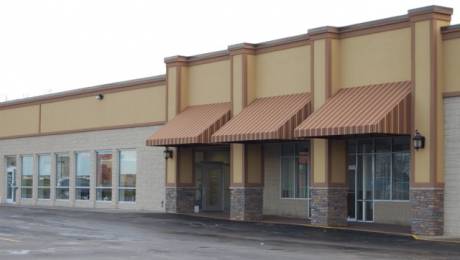
Le Roy ZBA hearing on Frostridge scheduled for Dec. 17
The joint Le Roy Zoning Board of Appeals will meet on Dec. 17 to conduct a public hearing on live music concerts at Frostridge Campground.
The hearing would take place a day before the deadline set last week by Interim Supreme Court Judge Mark Grisanti.
According to the public notice, Frostridge seeks an interpretation of two sections of town Zoning Code — sections 165-13 and 165-39(B) — “as they pertain to the property, particularly whether camping and attendant recreational activities, including live and recorded amplified music/concerts and limited food service are a prior non-conforming use.”
Section 165-13 establishes the legality of the prior, nonconforming use of buildings and lots. Section 165-39(B) relates to campsites: “All existing campsites of record shall be exempt from (Zoning Code), except that they shall comply with this section whenever they are sold or any addition, expansion or alteration of the use or operation is proposed.”
David and Greg Luetticke-Archbell purchased Frostridge Campground in 2008 and began having outdoor concerts in 2012. The town ZBA determined in 2013 that the concerts were a prior, nonconforming use, and thus legal under town zoning law.
Neighbors of the campsite and the Town of Le Roy both filed lawsuits alleging violations of zoning law.
This past April, Supreme Court Justice Robert C. Noonan invalidated the ZBA’s 2013 decision because the board failed to issue a proper public notice. He ordered the ZBA to schedule a new public hearing.
That hearing never took place. In November, the Town Board voted to withdraw from the intermunicipal agreement with the Village of Le Roy that established a joint ZBA and set a Dec. 10 public hearing on a law to establish a new, town-only zoning board.
The matter returned to Supreme Court where, last week, Grisanti ordered the town to cancel its Dec. 10 public hearing. He also ordered the existing ZBA to conduct a hearing on Frostridge by Dec. 18.
The ZBA hearing is scheduled for 7:30 p.m. Dec. 17 at Le Roy Town Hall, 48 Main St.
